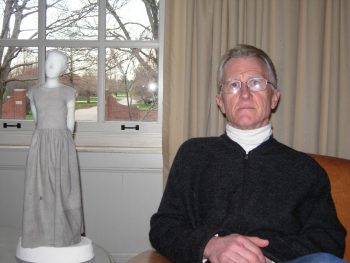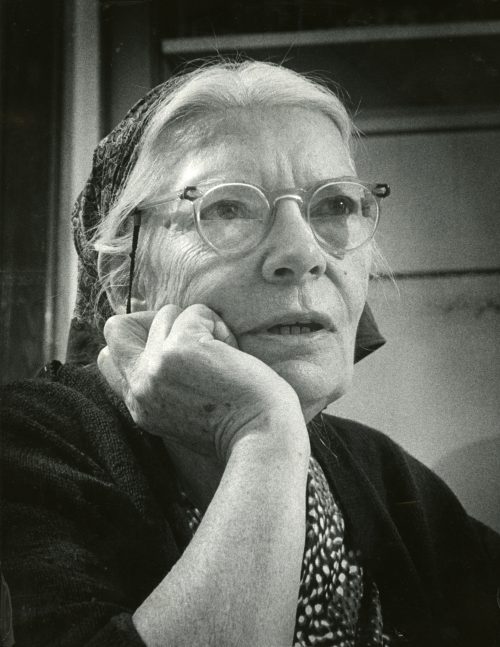 Mark Rothko’s 1953 “Untitled: Purple, White, and Red.”
Mark Rothko’s 1953 “Untitled: Purple, White, and Red.”
It’s almost August, summer is on the wane, the sun is setting toward the south, the great thunder clouds have been parking over Elmore to the northwest of an evening putting on a show of fireworks unlike anything I’ve ever seen, and now, you know, another issue is coming out, something chimerical in this one, a non-conformist issue forged around fiction by Curtis White and major essays on the great Catholic activist Dorothy Day and Ralph Waldo Emerson’s iconic “Self-Reliance” (which I read for the first time when I was 13 in the bathroom at the farm in Waterford because my mother made me). And more!
Who else brings you such strangeness?
Curtis White is an essayist, social critic and fiction writer out of the school of Laurence Sterne and Rabelais, that is, his style is unorthodox, playful, witty and knowing but not necessarily a pomo faddist. In the piece we have for August, he riffs on the American-Mexican western, jumping off Cormac McCarthy’s diving board, into, well, something different. Think: cowboys likening the ur-American landscape to a Mark Rothko painting. Think Blood Meridian and Joseph Cornell.
Chimerical/non-conforming.
So, tired but dogged, they saddled the horses and cut the girl loose from her stake. She rubbed at the raw welts on her wrist but climbed quickly on to her horse without complaint. She was in withdrawal from one or more opioids, and so was starting to think that the best thing for her was to arrive somewhere, anywhere. She was a hard girl after the long months in the criminal camp on the desert floor, and she’d seen her share of addicts piled on the ground their bones clattering like castanets. She was a girl who paid attention and learned, Jake gave her that, but he also knew he’d have to treat her without pity. Pity was something he didn’t have time for. So what if she had some bloody welts from the leather cords. Let her keep still then. —Curtis White
Laura Michele Diener returns to these pages with a mega-essay on Catholic-feminist-moral icon Dorothy Day who hitched her traditional theological loyaties to just about every advanced 20th century social movement.
She fought on the cusp of practically every crucial social movement of the twentieth century—against the war in Vietnam, against the Atom Bomb, on behalf of Civil Rights, labor, and suffrage. She didn’t just live as a Catholic, she lived according to Gospels, stripping herself of her possessions because Christ had commanded it, loving the poor—truly loving them, which was an act of will, because the poor, up close, can be horrifying. —Laura Michele Diener
 Cover image for The Domino Project’s edition of “Self-Reliance,” 2011.
Cover image for The Domino Project’s edition of “Self-Reliance,” 2011.
Pat Keane returns to his beloved Emerson whose controversial essay “Self-Reliance” let loose the demons and angels of our contemporary idolatry of the self, from hippies to self-help libraries. But what was he really saying?
Stylistically, Emerson is so committed to polarity that his powerful yet ambiguous texts are full of overstatements and qualifications, swerves and counter-swerves. In the second half of many lectures and essays, he takes away with the left hand what he has just given with the right. As he notoriously proclaimed in our main text, “Self-Reliance,” a “foolish consistency is the hobgoblin of little minds” (E&L 265). His disciple Walt Whitman was never more Emersonian than when (in “Song of Myself” §51) he asked a rhetorical question and responded audaciously: “Do I contradict myself?/ Very well, then, I contradict myself./ (I am large. I contain multitudes)”—to which Emerson’s German disciple, Friedrich Nietzsche, responded: “It is precisely such ‘contradictions’ that seduce one to existence.” —Patrick J. Keane
Also in fiction in August, we have a witty, insistent (those insistent, obsessive parallels), off-the-wall (in the best possible sense) short story from Evan Lavender-Smith.
I have a question.
—Shoot.
—Why do you say always shoot when I say I have a question?
—Shoot. It means go ahead and ask your question. Shoot, fire away, lay it on me. Ask your question.
—It does?
—Yes. What did you think it meant?
—That you were tired of me asking you so many questions. Like, oh no, here we go again. Like, you know, shoot.
—Evan Lavender-Smith
Allan Cooper, who last graced these pages extolling the poems of Frank Stanford, returns with brand new translations from Rainer Maria Rilke’s Duino Elegies.
But because being truly alive is difficult: because the fleeting
things of the world need us, and in a strange way
call out to us. And we’re the most fleeting of all.
Each living thing is here once, that’s it. And we
live once. But to have been here
once, completely alive here–
to have been a part of this world–nothing can take that away.
—Rainer Maria Rilke translated by Allan Cooper
From Mexican we have poems from the dazzling young writer Zazil Alaíde Collins with an interview by Dylan Brennan. The original Spanish translated by Cody Copeland.
Words are crabs
Buried in the deep.
Shipwrecks speak
in seashells.
The wind sings its syllables
of whispered names.
—Zazil Alaíde Collins translated by Cody Copeland
From Canada, Susan Gillis graces our pages for the first time with a gorgeous, powerful paean to a city, the poem formed around a central image, a towering construction crane seen from the poet’s window.
Boom, traveller, plumb, hook, cab – I will miss the yellow crane when the building is finished.
The crane has just lifted a load of steel I-beams and lowered them to a point I can’t see, though I can see the figures of people walking along the roof.
Days close in on a wasp’s nest of days.
Is there a procedure for emptying myself?
As when the sky suddenly empties and resurges toward a storm.
—Susan Gillis
Carolyn Ogburn pens here a review of Ben Lerner’s The Hatred of Poetry.
We might not have initially considered the comparison, but Lerner introduces it: “why not speak of it — fucking and getting fucked up was part of it, is, the way sex and substances can liquefy the particulars of perception into an experience of form. The way a person’s stutter can be liquefied by song.” Like sex, like speech itself, poetry is forever seeking purchase in the real, yet exists only in “the glimmer of virtual possibility.”
—Carolyn Ogburn
And one of our favourite fiction writers Cynthia Flood recounts a horrible true-life experience with amnesia.
Each August, my family rents a lakeside cottage at Shawnigan. Swim to the island and explore, row to the island for a picnic, canoe there with the dog anxiously aboard — everyday activities.
With my teenage grand-daughters, one afternoon I stepped into the refreshing lake-water, all sparkly in the sun, and began to swim.
Next: I am lying flat, wearing a blue hospital gown. A voice says, “We’ll take her up to the ward now.”
—Cynthia Flood
Daniel Lawless contributes whimsical, heart-felt poems, contemporary and vibrant with personality.
Or are you still thinking about that half-dressed dancing girl
With her scorched toddler-mind, how childishly beautiful she was
Making jewelry out of a snake,
The aroma of her pale breasts and the illicit thought
Of kissing them, taking them topped with Lychee Love Sauce
Into your mouth?
—Daniel Lawless
Lawrence Sutin sent in an essay on that perennial question “What is Reality?” and, of course, as you would expect, his answer is pure Sutin-esque whimsy.
We are not constructed to agree. The uniqueness that we claim we each possess, the distinctive consciousness we feel to be within ourselves and not within others, is very real in its billions upon billions of subtly human variations. Whether a meal is well-cooked or sadly dry, whether a city street is a triumph of order or a stream of chaos, these are questions that become unanswerable when asked of a human array of tasters and observers. And most of us have experienced being on both sides of the same question. The street we found charming one day becomes a biting snake the next. The person we thought we would love forever becomes a thought that we cannot imagine we ever thought, not really.
—Lawrence Sutin
Margaret Nowaczyk is a writing student with Caroline Adderson. She wrote this story based on the exercise I give in the short story structure essay in Attack of the Copula Spiders. The result was so astonishing, Caroline straight away shot off an email to me.
The first time he saw Adèle she was dancing on a chair at their med school orientation party. She wore autographed boxer shorts from an upper classman, the prize token for the scavenger hunt; a wide grin – all teeth – split her face, thick brown hair parted in a bob on the right. As she shook it off her face her eyes met Bentley’s and she winked at him, her face an invitation. Bentley felt his face grow hot.
They were sleeping together a month later. Bentley, virginal, realized right away that Adèle was much more experienced than he would allow himself to imagine. Her lipstick on his penis – kissing it, biting it, sucking it she smeared the crimson on the pearly pink of his shaft and foreskin. He pushed aside thoughts of the unnamed men, their greedy hands, their probing tongues and dicks that knew Adèle better than he did.
He realized then that he would never let go of her.
—Margaret Nowaczyk
Ben Woodard reviews Horacio Castellanis Moya’s Revulsion: Thomas Bernhard in San Salvador.
A blistering novella that satisfies the darkness clouding the cynical side of our souls.
— Benjamin Woodard
And Ted Deppe contributes lovely poems.
Start off singing a madrigal, return
with words a girl wrote on a wall
of a concentration camp, set to music
by Górecki. I didn’t learn he’d died
until the next day, but lingering
beneath such sadness, I didn’t need
to know. The music
stopped, I walked on,
and the lights in the valley
were candles in a starless church.
………………………………………………………—Ted Deppe
Though there is more, as always. NC at the Movies. Jason DeYoung reviewing the latest by Rikki Ducornet. Check out the issue when it starts to appear August 1st.
Chimerical/non-conformist.


















